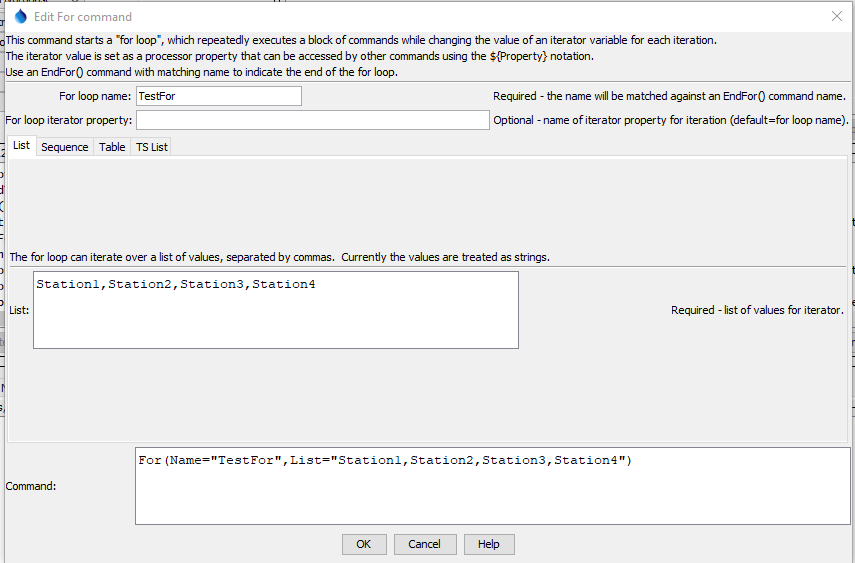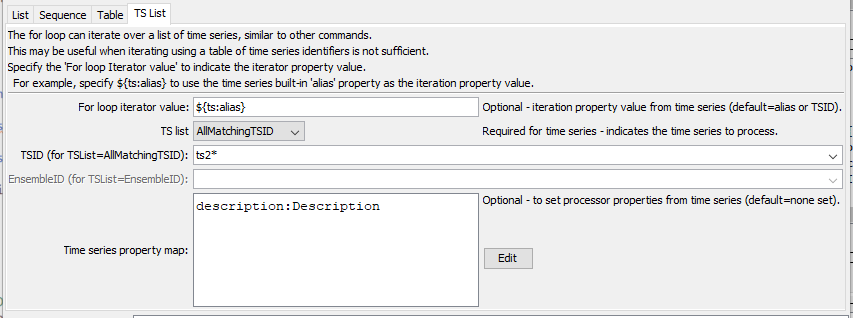TSTool / Command / For
Overview
The For command iterates through a block of commands between For and matching
EndFor commands.
A processor property is set to the value of the iteration property and can be used by other
commands that support properties, using the ${Property} notation.
For commands can iterate over:
- a list of supplied values (see the
Listparameter) - a sequence of integers or decimal numbers specified with start (
SequenceStartparameter), end (SequenceEndparameter), and increment (SequenceIncrementparameter) - values from a table column (see
TableID,TableColumn, andTablePropertyMapparameters) - a list of time series and corresponding properties (see
TSList,TSID, andEnsembleIDparameters)
For commands can be nested.
Status messages for run mode are accumulated in each command (this update is occurring over time –
status messages for some commands may be cleared out each iteration).
A limitation of using For with properties is that the command when edited may show time series
identifiers and other command parameters as ${Property} values,
rather than actual data, because the values get expanded at run-time.
This provides increased processing power but errors may not be evident until commands run.
See also the
Break and
Continue commands,
which can be used with
If command to skip some commands in a For loop.
Command Editor
The following dialog is used to edit the command and illustrates the command syntax when iterating over a list.

For Command Editor Illustrating Using a List for Iteration Values (see also the full-size image)
The following dialog is used to edit the command and illustrates the command syntax when iterating over a sequence of numbers.

For Command Editor Illustrating Using a Sequence of Integers for Iteration Values (see also the full-size image)
The following dialog is used to edit the command and illustrates the command syntax when iterating over table column values.

For Command Editor Illustrating Using a Table for Iteration Values (see also the full-size image)
The following dialog is used to edit the command and illustrates the command syntax when iterating over a list of time series.

For Command Editor Illustrating Using a List of Time Series (see also the full-size image)
Command Syntax
The command syntax is as follows. One of the list, sequence, or table parameters must be specified.
For(Parameter="Value",...)
Command Parameters
| Iterator Method | Parameter | Description | Default |
|---|---|---|---|
| All | Namerequired |
The name of the for loop, which will be matched with the name of an EndFor command to indicate the block of commands in the loop. |
None - must be specified. |
| All | IteratorProperty |
The processor property that will be set to the iterator property. The object type will depend on that used to provide the iteration property list. For example, if a sequence of integers is being iterated, the property will contain an integer. | Same as Name. |
| List | List |
A list of comma-separated values to be used as variables for the iteration. Can use ${Property} syntax. |
No default if list is used – must specify a list of values. |
| Sequence | SequenceStart |
Starting value when a sequence is specified for iteration, an integer or decimal number. | No default if sequence is used. |
| Sequence | SequenceEnd |
Ending value when a sequence is specified for iteration, an integer or decimal number. | No default if sequence is used. |
| Sequence | SequenceIncrement |
Increment for sequence iterator. | 1 or 1.0 depending on inferred type for SequenceStart. |
| Table | TableID |
The table identifier, when specifying the iterator as a column from a table. Can be specified with processor ${Property}. |
No default if table is used - required if table is used. |
| Table | TableColumn |
The table column name, when specifying the iterator as a column from a table. | No default if table is used - required if table is used. |
| Table | TablePropertyMap |
Specify the names of column names and corresponding processor property names to set. This allows other commands to access the values of those properties using ${Property} notation. Specify using format:ColumnName1:PropertyName1,ColumnName2:PropertyName2 |
No default if table is used - required if table is used. Only the iterator column value will be set as a property using IteratorProperty. |
| TS List | TSList |
Indicates the list of time series to be processed, one of:
|
If iterating time series, must be specified. |
| TS List | TSID |
The time series identifier or alias for the time series to be processed, using the * wildcard character to match multiple time series. Can be specified using ${Property}. |
Required if TSList=*TSID |
| TS List | EnsembleID |
The ensemble to be processed, if processing an ensemble. Can be specified using ${Property}. |
Required if TSList=*EnsembleID |
| TS List | TimeSeriesPropertyMap |
Map of time series property names to processor processor property names, which allows time series properties to be made visible for processing. | No additional time series properties other than iterator property are set as processor properties. |
Examples
See the automated tests.
Example to process data for a list of counties
The following example illustrates a simple For and EndFor usage.
In this example the StationID column in the input table is used to provide the list of values to iterate over.
The following input table is a delimited file but could come from another source:
# Test table data for For() command tests
"Count","Val","StationID","Basin"
1,1.0,Station1,Basin1
2,2.0,Station2,Basin2
3,3.0,Station3,Basin3
4,4.0,Station4,Basin4
The following command file reads the above input table, iterates over the StationID column, and creates a simple output file:
ReadTableFromDelimitedFile(TableID="Table1",InputFile="Data\testtable.csv")
RemoveFile(InputFile="Results/Test_For_TableString_out.txt",IfNotFound=Ignore)
For(Name="TestFor",TableID="Table1",TableColumn="StationID")
WritePropertiesToFile(OutputFile="Results/Test_For_TableString_out.txt",
IncludeProperty="TestFor",WriteMode=Append,FileFormat=NameTypeValue)
EndFor(Name="TestFor")
The resulting output file is as follows:
TestFor="Station1"
TestFor="Station2"
TestFor="Station3"
TestFor="Station4"